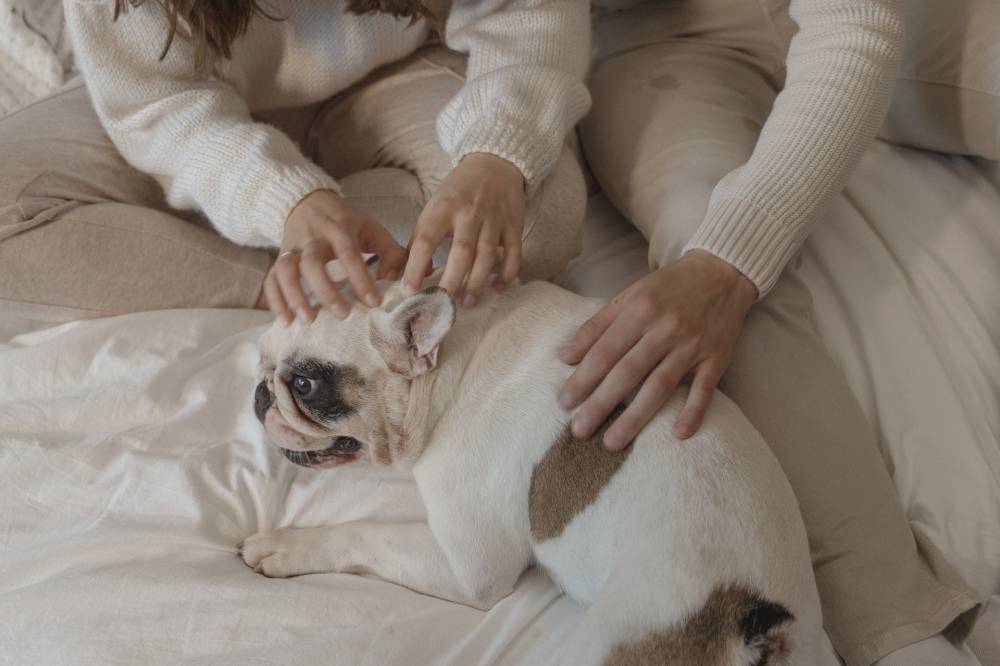Quick Navigation
Dogs love to be touched almost everywhere on their body, not just on the lower back.
They love those little massages and those little gentle strokes we give to them from time to time.
It is because it makes dogs feel loved, and they get to pick up our energy from the kind of touch we give them.

Dogs can yelp when touched on the lower back due to fear, anger, or pain.
For instance, if the dog suddenly gets touched in the back, the dog can yelp in fear.
Why Does The Dog Yelp When Touch On The Lower Back? – 9 Reasons
It could be fine when anywhere except the lower back is touched. However, when the lower back is touched, the dog yelps.
Dogs communicate through body language.
Nonetheless, if a dog continues to yelp when touched on the lower back, the dog is most likely experiencing some pain in the lower back.
If a dog is experiencing pain in the lower back, closer observation should be taken to monitor the dog’s movement.
Other symptoms that indicate intense pain in the dogs’ lower back include:
- Limping
- Whimpering
- Staggering
The pain experienced by the dog can be a result of any of the following:
1. Injury
Dogs can be highly energetic and are fond of getting injured due to the uncontrolled burst of energy.
In the heat of excitement, muscles in their lower back can experience enough pressure to stretch.
If those muscles are stretched far too much and repeatedly, dogs can accidentally strain the muscles in their lower back.
Even activities like jumping off the stairs can cause minor injuries to the dogs’ lower back.
It is because a wrong jump can strain a dog’s hip and thighs.
2. Spinal Arthritis
Spinal arthritis is a common factor to consider when discussing the major causes of pain in a dog’s lower back.
This health condition is common in large dog breeds like the German shepherd.
Arthritis is a disease that affects the joints.
It involves the inflammation or degeneration of the joint, which can influence pain when moving those joints.
Arthritis can occur at any joint, while spinal arthritis is explicitly related to the joints in the spinal cord.
Senior dogs are predictable to be diagnosed with the disease.
It is because the shape of the dog’s spine and position exerts pressure on the vertebrae.
With time the vertebrae’s cartilage wears out, and the cells will gradually die.
When this happens, they produce enzymes that trigger inflammation in the joints.
This inflammation reduces the dogs’ mobility and causes pain in the dogs’ lower back.

3. Intervertebral Disc Disease
Intervertebral Disc Disease is usually common in dogs that have short legs and medium or long backs.
The intervertebral disk is located below the spinal cord to support movement in dogs.
Intervertebral disc disease occurs when the disk’s center becomes fragile, and the disk can rupture without any warning.
The main reason behind this disease is old age.
As dogs get older, they gradually lose their flexibility, and their bones get weak.
4. Lumbosacral Syndrome
Diseases like arthritis, intervertebral disc disease, and spinal tumors can cause the bones in the spinal cord to exert pressure on the nerves.
The pressure on the nerves can cause the spinal canal to wear thin and narrow.
The narrowing of the spinal canal can lead the spinal nerve root to narrow down.
When the spinal root nerves become shallow, the condition is called lumbosacral syndrome.
To sum it up, the lumbosacral syndrome is usually the aftermath of spinal arthritis or intervertebral disc disease.
This condition is most common in medium- to large-breed dogs such as German shepherds and working dogs, and dogs of middle to older age.
5. Hip Dysplasia
Hip dysplasia can affect any dog breed, not just large dogs or dogs with short legs and long backs.
It is a disease that affects the ball and socket joints.
It occurs when the bones in the ball and socket joint do not grow properly.
When one bone grows bigger than the other, that particular joint will have restricted movement.
It is because the bones will grind each other instead of slicing into each other perfectly.
There are dogs that are more likely to attain this health condition as they grow older, like the Labrador Retriever.
However, nutrition, breed disposition, quality, and quantity of exercise are all factors that influence the development of this disease.
6. Inflammatory Diseases
Inflammatory diseases can be a result of infections like bacteria, protozoa, or parasites.
Protozoal Diseases
Foreign microorganisms can cause inflammation in the spinal cord, hindering the dogs’ movement in the process.
Inflammation caused by protozoa microorganisms can lead to:
- Neosporosis
- Toxoplasmosis
- Parasitic diseases
The common parasites found in dogs are roundworms, tapeworms, and hookworms. Parasites like these can eat up tissues.
They may cause permanent damage to the tissues surrounding the spinal cord if not treated promptly.
An example of a disease caused by parasites is verminous myelitis.
7. Meningitis
A membrane called the meninges covers the spinal cord.
This membrane protects the spinal cord from shock and physical trauma.
Meningitis is a condition that occurs when the meninges become inflamed.
Inflammation of the meninges can result from bone infections in the spinal cord.
It has the ability to join the bones and tissues in the vertebrae.
Dogs could experience pain in their lower back once the bones and tissues join.
The condition could reduce their mobility thus, dogs may be frequently lethargic and might even refuse food.
Fever, widespread pain (which may be severe), and stiff neck are typical clinical indicators of meningitis.
8. Spondylosis
Spondylosis is a degenerative condition that occurs in the lumbar vertebrae. How likely is spondylosis to develop?
It may go unnoticed for years or even the entire lifespan of the dog if there are no symptoms.
The presence of bony spurs in the vertebrae indicates that there is spondylosis.
The bony spurs are located in the lumbar vertebrae (lower back) or the joints in the lower back.
The bony spurs can either have a minor or major impact on the mobility of the bones in the dogs’ lower back.
It will depend on the size and quantity of the bony spurs.
The development of bony spurs can be a result of damage to the intervertebral disk.
They can also be a result of damage to any of the bones in the lumbar vertebrae.
The damage can be a consequence of major accidents to the lower back or old age.
Even though they may have some flexibility and range of motion limitations, many affected dogs lead happy lives.
9. Nephroblastoma
Another reason dogs experience pain in their lower back can be a result of a tumor in the spinal column.
Nephroblastoma is a rare tumor that develops in dogs under two years of age.
Although this tumor is rare, it is life-threatening when there are no immediate treatment procedures.
Embryonic renal tissue caught in the dura of the spinal canal during fetal development may cause the growth of this tumor.
There are few treatment options for nephroblastoma, and in veterinary medicine, the main option is surgical debulking (removal).
After surgery, radiation therapy is thought to provide additional benefits.
What To Do About It?
It is important to know the underlying cause of the dog’s lower back pain.
Book an appointment with a veterinarian to conduct physical and neurological tests to determine the dog’s lower back pain source.
Spinal rays and MRI scans can also be taken.
It is to confirm if they are any signs of physical damage to the spinal cord.
Depending on the prognosis, the vet may prescribe surgery or medications as a treatment for the dog’s lower back.
After treatment, the dog should wear back braces and support straps.
This is to support the dog’s spine as well as the surrounding muscles.
The dog should also have healthy nutrition and lots of rest.
So that the dog can adequately heal no matter the prognosis and for the lower back not experience further damage.

Lucy is a real-time contributor to Purrfect n’ Pawesome, along with being a freelance writer to various pet forums and platforms. She started writing professionally in the year 2016. Earlier, she enjoyed her community life as a pet rescue volunteer and offered boarding services to pet owners. Her extensive experience in the pet field is now the basis for her writing at this site.
She loves to collect animal facts from around the globe and then transform them into amazing stories for her readers. For Lucy, the mission is to bring pet love to every home and equip the pet parents with the required useful and authentic information to nurture their pet accordingly.
She lives with her two cats and a shepherd mix, whom she loves the most. Despite her extremely busy life, she spends some time with wildlife and outer space to relax her mind and enhance her observation.
Purrfect n’ Pawesome is a platform that believes in providing our pets with the right kind of nurturing, care and upbringing to assist them in leading a healthy life. Go to our blog section and read out some pawesome and informative articles to ease your parenthood.






